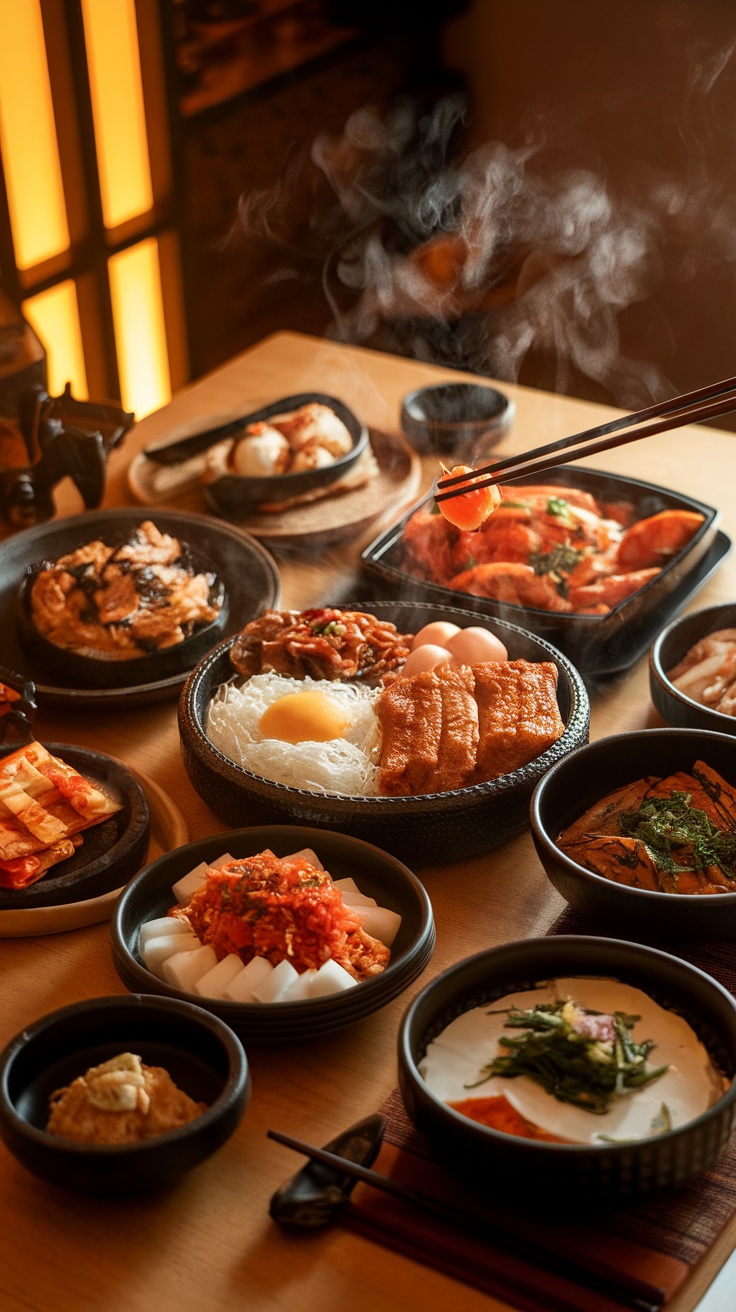Korea’s culinary scene is a rich tapestry woven from centuries of history, culture, and tradition. From the spicy kick of kimchi to the comfort of bibimbap, each of these popular dishes carries its own story, shaped by the land and people who created it. As we explore the origins, cultural significance, and evolution of these beloved meals, we’ll also highlight traditional cooking methods and the modern twists that have made them household staples in Korea and beyond.
Korea’s Most Popular Dishes
1. Kimchi – The Ancient Fermented Staple
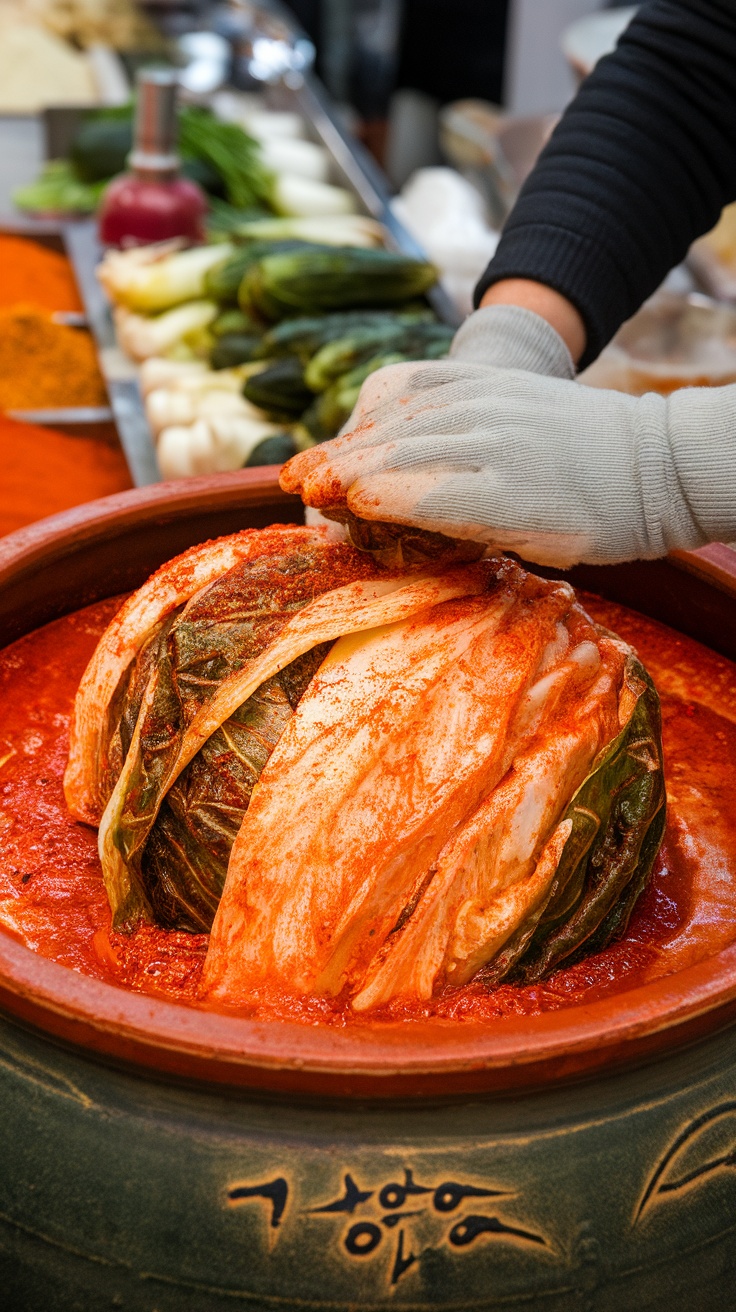
Kimchi is not just a dish; it’s a way of life in Korea. This fermented vegetable dish, often made with napa cabbage and a blend of spices, delivers a punch of flavor with its spicy, tangy, and umami notes. While it might seem intricate, making kimchi is quite straightforward, as it relies on the fermentation process to develop its unique taste. Plus, it’s a fantastic way to preserve vegetables, making it both practical and delicious.
The origins of kimchi date back to ancient Korea, where it was primarily developed as a method of food preservation during harsh winters. Over time, it has evolved significantly, adapting to regional variations and available ingredients. Historically, kimchi was a vital source of nutrition, especially during the off-season when fresh produce was scarce. Today, it holds cultural significance, often accompanying meals and being central to Korean identity.
Traditional methods of making kimchi involve hand-mixing ingredients and carefully layering them for optimal fermentation in earthenware pots. In modern kitchens, you’ll find quicker adaptations that use fermentation jars or even refrigerators, allowing for more convenience without sacrificing flavor. Regardless of the method, kimchi remains a staple, celebrated in various forms across Korea and even beyond.
Ingredients
- 1 large napa cabbage
- 1/2 cup sea salt
- 4 cups water
- 1 tablespoon grated ginger
- 4 cloves garlic, minced
- 2 tablespoons fish sauce (or soy sauce for a vegetarian option)
- 3 tablespoons Korean red pepper flakes (gochugaru)
- 1 tablespoon sugar
- 2 carrots, julienned
- 4 green onions, chopped
Instructions
- Prepare the Cabbage: Cut the napa cabbage in half lengthwise, then into quarters. Dissolve sea salt in water, and soak the cabbage in the salted water for about 2 hours, turning occasionally.
- Make the Paste: In a bowl, combine grated ginger, minced garlic, fish sauce, gochugaru, and sugar. Mix until it forms a paste.
- Combine Ingredients: Rinse the cabbage under cold water to remove excess salt, and drain well. In a large bowl, combine the cabbage, carrot, green onions, and the paste. Mix thoroughly, using gloves for convenience.
- Pack and Ferment: Pack the mixture into a clean jar, pressing down to remove air bubbles. Leave some space at the top for expansion. Seal the jar and let it ferment at room temperature for 1-2 days, depending on your taste preference.
- Store: After fermentation, transfer the kimchi to the refrigerator. It can be enjoyed immediately but will develop deeper flavors over time.
2. Bibimbap – A Royal Meal Turned Everyday Favorite
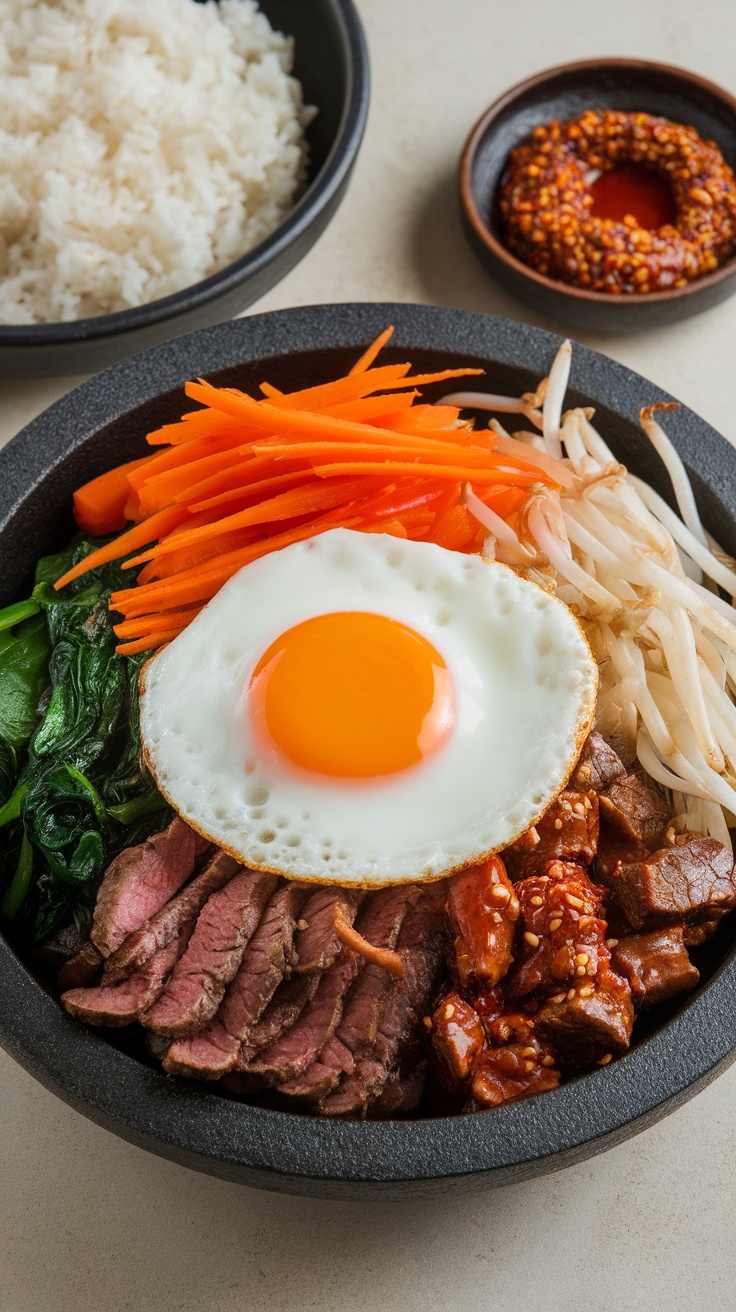
Bibimbap is a popular Korean dish made with rice, vegetables, meat, and a fried egg. It is colorful and tasty, offering a mix of flavors and textures that make it filling and nutritious. Bibimbap is easy to prepare, which allows for creativity in cooking, making it a favorite for home cooks.
This dish originally came from royal cuisine but has become a beloved everyday meal. It started as a way to use leftover ingredients, which shows its flexible nature. Bibimbap also represents harmony and balance, linked to the Korean idea of ‘cheong’ or ‘purity.’ Traditionally, each ingredient is cooked separately to highlight its flavor. Today, there are many modern versions of bibimbap that cater to different diets, including vegetarian and vegan options.versions.
Ingredients
- 2 cups cooked short-grain rice
- 1 cup spinach, blanched
- 1 cup carrots, julienned
- 1 cup bean sprouts, blanched
- 1 cup beef, thinly sliced (or tofu for a vegetarian version)
- 1 egg
- 2 tablespoons gochujang (Korean chili paste)
- 1 tablespoon soy sauce
- 1 tablespoon sesame oil
- Sesame seeds, for garnish
Instructions
- Prepare the Beef: Marinate the thinly sliced beef with soy sauce and sesame oil for about 30 minutes. Cook in a pan over medium heat until desired doneness.
- Sauté the Vegetables: In separate pans, quickly sauté the spinach, carrots, and bean sprouts with a bit of sesame oil and salt until tender.
- Fry the Egg: In a non-stick pan, fry an egg sunny-side up, ensuring the yolk remains runny.
- Assemble the Bibimbap: In a large bowl, layer the cooked rice as the base, then artfully arrange the sautéed vegetables and beef on top. Place the fried egg in the center.
- Serve: Drizzle gochujang over the top, sprinkle with sesame seeds, and mix everything together just before eating.
3. Bulgogi – The Evolution Of Korea’S Iconic Bbq
![]()
Bulgogi is a savory Korean dish made from marinated beef that’s grilled to perfection. Its delightful combination of sweet and savory flavors makes it a favorite among many, and it’s surprisingly simple to prepare at home. The tender, juicy slices of beef are often served with lettuce leaves, rice, and various side dishes, creating a full and satisfying meal.
This dish has deep roots in Korean history, originating from the Goguryeo era, where it was known as ‘maekjeok.’ Over time, bulgogi has evolved, incorporating diverse ingredients and cooking methods. Traditionally, thinly sliced beef is marinated in a mixture of soy sauce, sugar, sesame oil, and garlic, providing a robust flavor that enhances the grilling process. Today, modern adaptations may include different proteins and creative sides, making it a versatile choice for any occasion.
Ingredients
- 1 pound beef sirloin, thinly sliced
- 1/4 cup soy sauce
- 2 tablespoons brown sugar
- 1 tablespoon sesame oil
- 4 cloves garlic, minced
- 1 tablespoon ginger, grated
- 1/4 cup green onions, chopped
- 1 tablespoon sesame seeds
- 1 tablespoon vegetable oil (for grilling)
- Lettuce leaves, for serving
- Cooked rice, for serving
Instructions
- Prepare the Marinade: In a bowl, mix soy sauce, brown sugar, sesame oil, garlic, ginger, green onions, and sesame seeds.
- Marinate the Beef: Add the sliced beef to the marinade, ensuring all pieces are well coated. Cover and refrigerate for at least 30 minutes, or up to 4 hours for deeper flavor.
- Grill the Beef: Preheat a grill or grill pan over medium-high heat. Add vegetable oil to prevent sticking. Grill the marinated beef for about 3-4 minutes per side, or until cooked to your desired doneness.
- Serve: Serve the grilled bulgogi with lettuce leaves and rice. You can also add toppings like kimchi or pickled vegetables for extra flavor.
4. Japchae – A Noodle Dish With Royal Beginnings
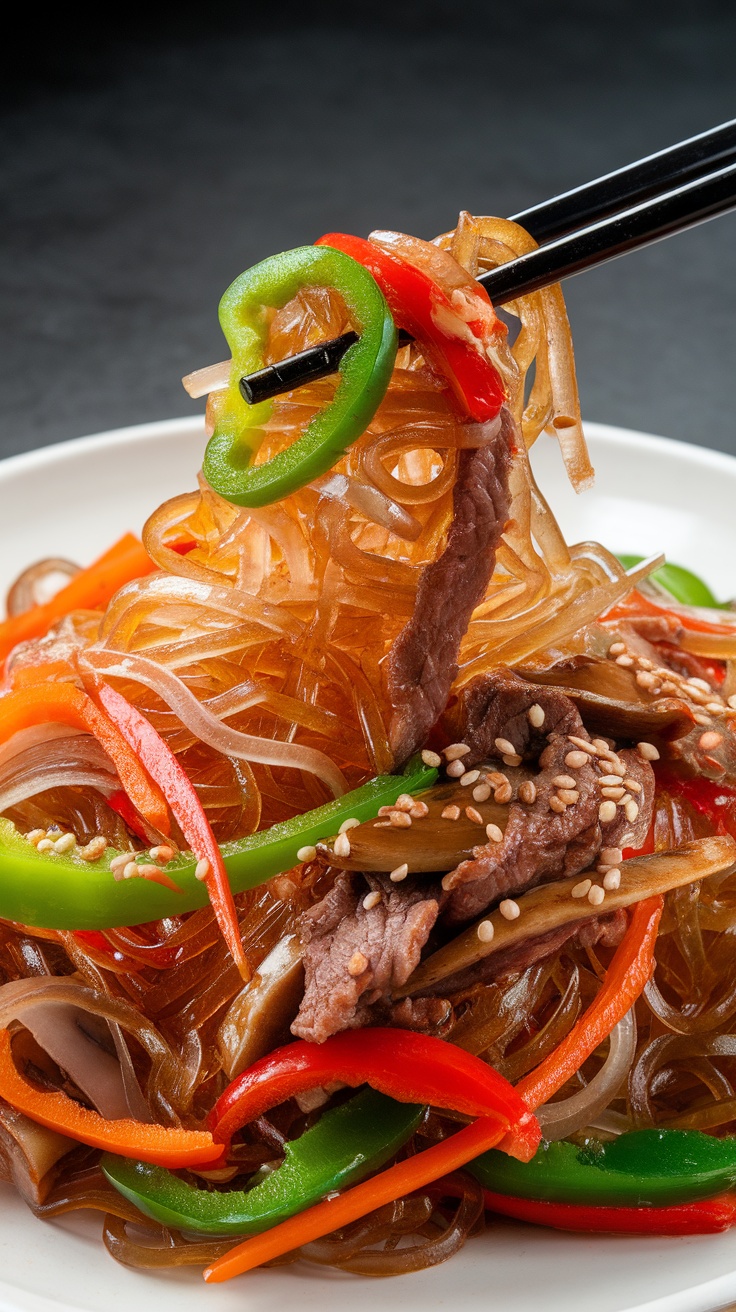
Japchae is a beloved Korean noodle dish made from sweet potato starch noodles, known as dangmyeon. It combines the chewy noodles with a variety of colorful vegetables and often includes meat, creating a dish that is both visually appealing and delicious. The flavors are savory and slightly sweet, thanks to the soy sauce and sesame oil, making it a crowd-pleaser at any table.
This dish is quite simple to prepare, making it a great option for both beginners and seasoned cooks. The versatility of japchae allows you to use whatever vegetables you have on hand, making it easy to adapt to personal tastes.
Origins of japchae date back to the 17th century during the reign of King Gojong of the Joseon Dynasty. It was initially served in royal courts and has since evolved into a popular dish across Korea. The cultural significance of japchae is evident as it is often served during celebrations and special occasions, symbolizing prosperity and good fortune.
Over the years, traditional cooking methods have transformed, but the essence of japchae remains the same. While it was once made exclusively with meat and specific vegetables, modern adaptations often include a range of ingredients, catering to vegetarian and vegan diets without losing the dish’s core flavors.
Ingredients
- 8 oz sweet potato noodles (dangmyeon)
- 1 cup sliced beef (or tofu for a vegetarian option)
- 1 cup shiitake mushrooms, sliced
- 1 cup spinach
- 1 cup carrots, julienned
- 1 bell pepper, sliced
- 4 tablespoons soy sauce
- 2 tablespoons sesame oil
- 2 tablespoons sugar
- 1 tablespoon sesame seeds
- 2 cloves garlic, minced
Instructions
- Cook the noodles: Boil water and cook the sweet potato noodles according to package instructions. Drain and rinse under cold water.
- Prepare the vegetables: In a large pan, heat some oil and sauté the garlic. Add the mushrooms, carrots, and bell pepper, cooking until tender. Add the spinach last and cook until wilted.
- Cook the meat (or tofu): In the same pan, add the sliced beef and cook until browned. If using tofu, sauté until golden.
- Combine: Add the cooked noodles to the pan along with soy sauce, sesame oil, and sugar. Toss everything together until well mixed and heated through.
- Serve: Transfer to a serving dish and sprinkle sesame seeds on top. Enjoy warm or at room temperature.
5. Tteokbokki – From Royal Court Cuisine To Street Food Sensation
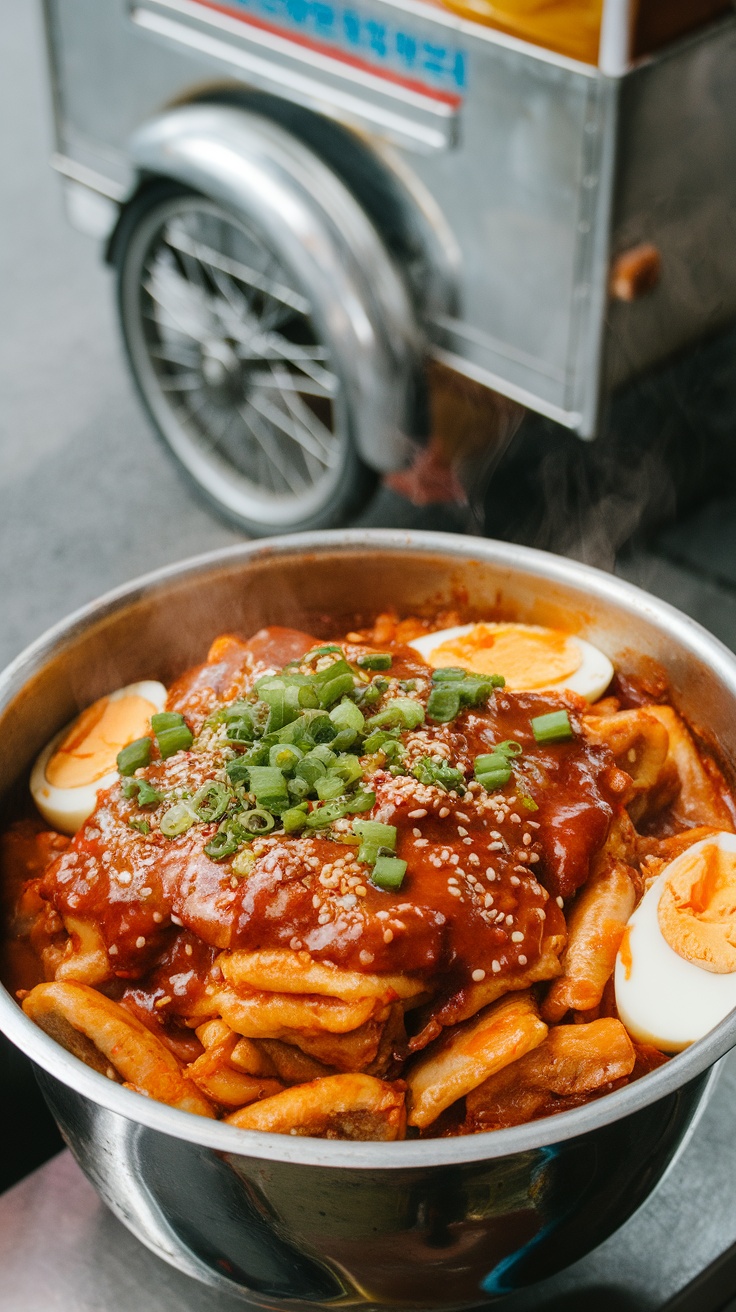
Tteokbokki is a delightful dish that showcases the rich flavors of Korean cuisine. Made primarily with chewy rice cakes, the dish is often simmered in a spicy and slightly sweet sauce, creating a comforting and satisfying meal. It’s easy to prepare, making it a popular choice for both home cooks and street vendors alike.
Traditionally enjoyed in royal courts, tteokbokki has transformed into a beloved street food sensation. Its vibrant combination of flavors and textures captures the essence of Korea’s most popular dishes, connecting generations through its evolution over time. Whether you prefer it spicy or mild, the dish adapts to different tastes, making it a versatile favorite.
Ingredients
- 1 pound of cylindrical rice cakes (tteok)
- 4 cups of water
- 3 tablespoons gochujang (Korean chili paste)
- 1 tablespoon gochugaru (Korean chili flakes)
- 2 tablespoons sugar
- 2 teaspoons soy sauce
- 2 green onions, chopped
- 1 boiled egg (optional)
- Sesame seeds for garnish
Instructions
- Soak the rice cakes in warm water for about 30 minutes if they are hard.
- In a pot, combine water, gochujang, gochugaru, sugar, and soy sauce. Bring to a simmer over medium heat.
- Add the soaked rice cakes to the pot and cook, stirring occasionally, for about 10-15 minutes until the sauce thickens and the rice cakes are tender.
- Stir in chopped green onions and mix well to combine.
- If desired, serve with a boiled egg on top and sprinkle with sesame seeds for garnish.
6. Samgyetang – The Hearty Soup For Health And Strength
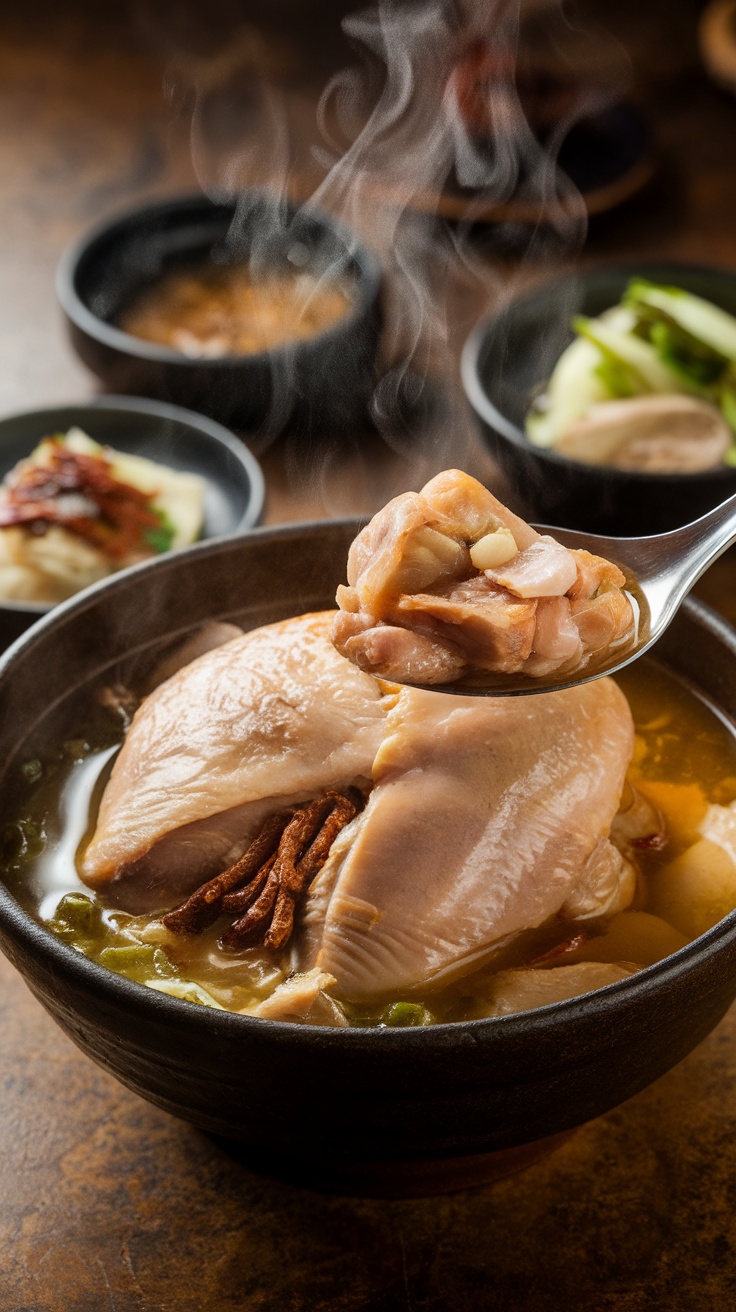
Samgyetang is a traditional Korean chicken soup that is both nourishing and comforting. Made with a whole young chicken stuffed with glutinous rice, ginseng, garlic, and various herbs, this dish is known for its rich flavor and health benefits. Its warm, savory broth is perfect for revitalizing the body, especially during the hot summer months.
The origins of samgyetang can be traced back to the Joseon Dynasty, where it was believed to restore vitality and strength. This hearty soup reflects Korea’s cultural significance placed on food as medicine. Over time, as dietary preferences evolved, variations of samgyetang have emerged, incorporating modern ingredients while maintaining its healthful essence. Traditionally prepared by simmering the chicken until tender, the soup has adapted to contemporary cooking methods, making it accessible for home cooks everywhere.
Ingredients
- 1 whole young chicken (about 2-3 pounds)
- 1 cup glutinous rice, soaked in water for at least 2 hours
- 4-5 slices of ginseng (fresh or dried)
- 5-6 cloves garlic, peeled
- 2-3 slices of ginger
- 1-2 green onions, chopped
- Salt and pepper to taste
- 8 cups water
- Optional: jujube (Korean dates) for sweetness
Instructions
- Prepare the Chicken: Rinse the chicken under cold water and remove any innards. Pat dry with paper towels.
- Stuff the Chicken: Fill the cavity of the chicken with soaked glutinous rice, ginseng, garlic, and ginger. Use kitchen twine to tie the legs together to keep the stuffing inside.
- Simmer: In a large pot, add the stuffed chicken and pour in the water. Bring to a boil, then reduce to a simmer. Cook for about 1.5 to 2 hours until the chicken is tender and fully cooked.
- Season: Taste the broth and add salt and pepper to your liking. If desired, add jujube for a touch of sweetness.
- Serve: Ladle the soup into bowls, garnish with chopped green onions, and enjoy while hot.
7. Jjajangmyeon – The Korean-Chinese Fusion Dish With A Rich History
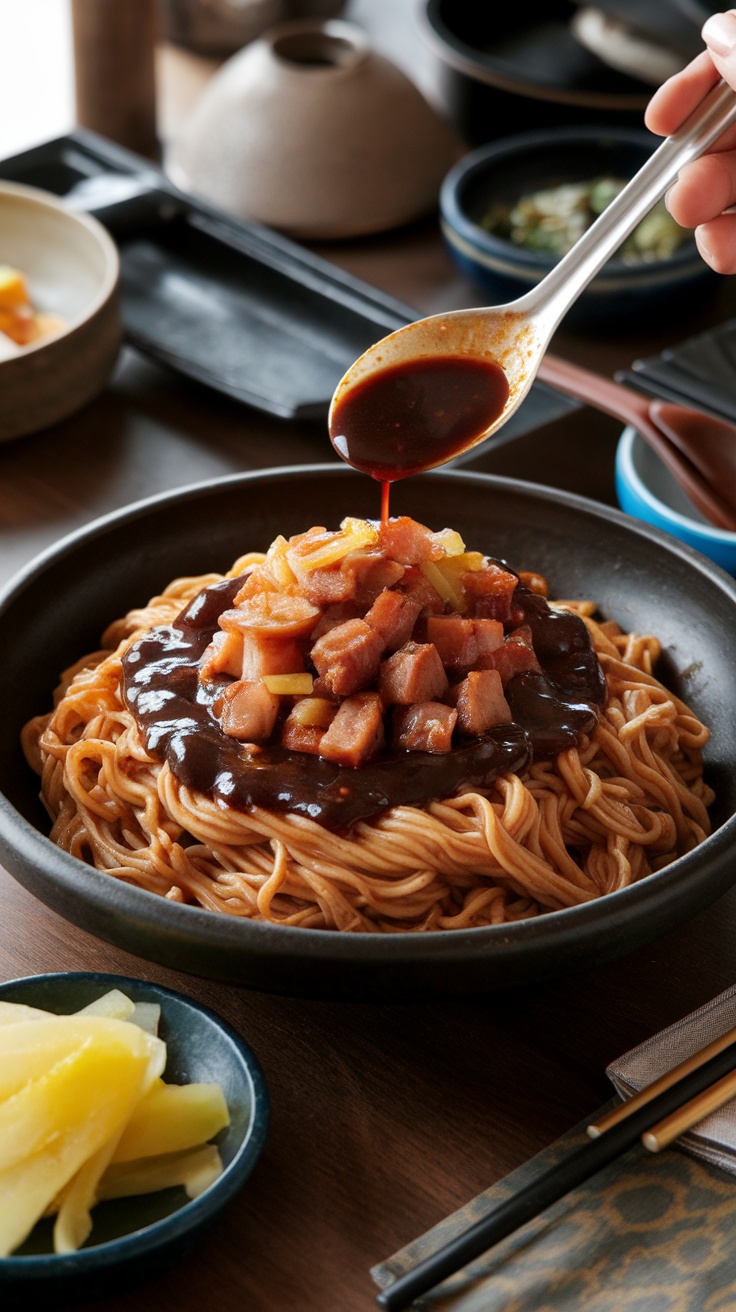
Jjajangmyeon is a delightful dish that blends Korean and Chinese culinary traditions, featuring chewy noodles topped with a savory black bean sauce. The sauce is rich and slightly sweet, often mixed with diced pork and vegetables, creating a comforting and hearty meal. Simple to prepare, it brings a unique taste experience that’s both satisfying and delicious.
This dish has roots that date back to the late 19th century, when Chinese immigrants introduced it to Korea. Over time, jjajangmyeon has evolved into a beloved staple in Korean cuisine, represented in countless family meals and celebrations. Traditionally, it was served in special occasions, but now it’s common to enjoy it casually, often paired with pickled radishes. Modern adaptations have introduced variations, including vegetarian options, making it even more accessible to everyone.
Ingredients
- 2 servings of fresh or dried jjajangmyeon noodles
- 1 tablespoon vegetable oil
- 100 grams pork belly, diced
- 1/2 onion, finely chopped
- 1 zucchini, diced
- 1/2 cup fermented black bean paste (jjajang)
- 1 tablespoon sugar
- 2 cups water
- 1 tablespoon cornstarch mixed with 2 tablespoons water (for thickening)
- Pickled radishes, for serving
Instructions
- Cook Noodles: Boil water in a large pot. Cook the jjajangmyeon noodles according to package instructions until al dente. Drain and set aside.
- Prepare the Sauce: In a pan, heat vegetable oil over medium heat. Add diced pork belly and cook until browned. Add the chopped onion and zucchini, cooking until softened.
- Mix in Black Bean Paste: Stir in the fermented black bean paste and sugar, mixing well. Pour in the water and bring to a simmer.
- Thicken the Sauce: Gradually add the cornstarch mixture, stirring until the sauce thickens to your desired consistency.
- Combine and Serve: Toss the cooked noodles in the sauce until well coated. Serve hot with pickled radishes on the side.
8. Sundubu-Jjigae – The Spicy Tofu Stew Born From Simplicity
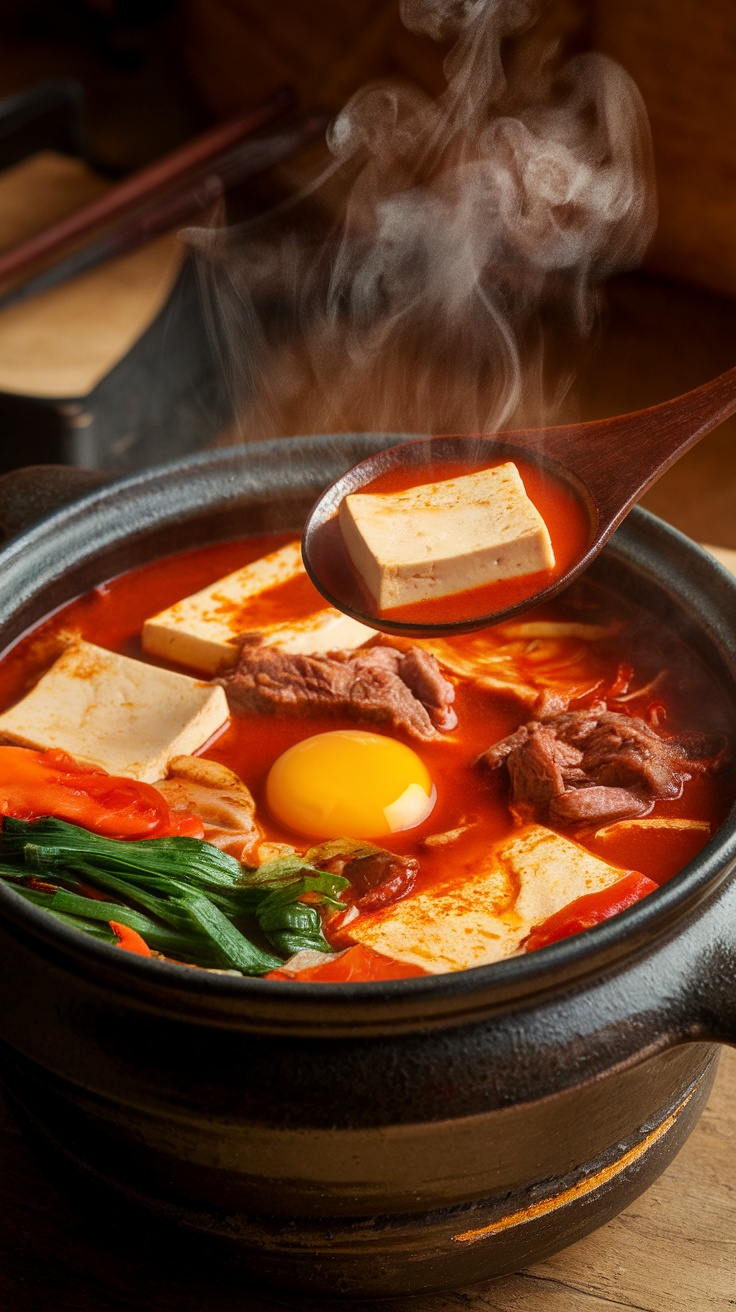
Sundubu-jjigae is a delightful Korean stew that brings a spicy kick to your dinner table. Made from uncurdled tofu, this dish is both rich and comforting, with a balance of flavors that warms you from the inside out. It’s simple to make and perfect for chilly days or when you need something hearty yet easy.
This stew has deep roots in Korean culture. Its origins can be traced back to humble beginnings when it was often prepared using leftover ingredients. Over time, it evolved into a beloved dish, showcasing a variety of flavors and textures. Traditional cooking methods involve simmering the stew in a clay pot, allowing the ingredients to blend together beautifully. As Korea’s culinary scene has modernized, adaptations have emerged that cater to different tastes, including vegetarian and vegan versions. However, the essence of Sundubu-jjigae remains the same: a satisfying meal that speaks to the heart of Korean cuisine.
Ingredients
- 2 cups of uncurdled tofu (sundubu)
- 1/2 cup beef or pork, thinly sliced (optional)
- 1 tablespoon vegetable oil
- 1/4 cup chopped onion
- 2 cloves garlic, minced
- 1 tablespoon gochugaru (Korean red pepper flakes)
- 2 cups vegetable or beef broth
- 1/2 cup zucchini, diced
- 1/2 cup mushrooms, sliced
- 1 egg
- 2 green onions, chopped
- Salt and pepper to taste
Instructions
- Heat vegetable oil in a clay pot over medium heat. Add onions and garlic, sautéing until fragrant.
- Add the sliced meat (if using) and cook until browned.
- Stir in gochugaru and cook for another minute.
- Pour in broth, then add tofu, zucchini, and mushrooms. Bring to a boil, then reduce to a simmer for about 10 minutes.
- Crack an egg into the stew just before serving, allowing it to poach gently.
- Garnish with chopped green onions and season with salt and pepper to taste. Serve hot with rice.
9. Gimbap – Korea’S Take On The Sushi Roll With A Unique Story

Gimbap, often referred to as Korea’s version of sushi, is more than just a delicious dish; it’s a culinary delight that tells the story of Korean culture. This iconic recipe features seasoned rice, a variety of colorful fillings, and a roll wrapped in seaweed, creating a delightful combination of flavors and textures. Gimbap is both savory and slightly sweet, with the addition of ingredients like pickled radish, carrots, and beef, making it a favorite among many.
Traditionally, gimbap has roots in Korea’s history, dating back to the late 19th century when it was influenced by Japanese sushi. Over time, it has evolved to reflect local tastes and ingredients, becoming a staple for picnics and gatherings. The dish not only showcases the artistry involved in its preparation but also highlights its significance in family and community bonding. Making gimbap can be simple and fun, offering a chance to customize fillings to your liking.
Ingredients
- 2 cups cooked short-grain rice
- 2 tablespoons sesame oil
- 1 teaspoon salt
- 4 sheets of seaweed (nori)
- 1 cup spinach, blanched
- 1 carrot, julienned
- 1 cucumber, julienned
- 4 eggs, beaten and cooked into a thin omelet
- 1 cup beef, marinated and cooked
- Pickled radish (danmuji), sliced
Instructions
- Prepare the Rice: In a bowl, mix the cooked rice with sesame oil and salt until well combined. Let it cool slightly.
- Prepare Fillings: In separate bowls, prepare blanched spinach, cooked and seasoned vegetables, sliced omelet, and marinated beef.
- Assemble Gimbap: Place a sheet of seaweed on a bamboo mat. Spread a thin layer of rice, leaving a border at the top. Layer the fillings horizontally across the rice.
- Roll It Up: Using the mat, carefully roll the seaweed tightly, pressing as you go to shape the roll. Seal the edge with a little water.
- Slice and Serve: Use a sharp knife to slice the roll into bite-sized pieces. Serve with soy sauce or dipping sauce for an extra kick.
10. Hoddeok – The Sweet Pancake With Global Influences

Hoddeok is a delightful Korean pancake that combines a crispy exterior with a warm, gooey filling, typically made of brown sugar, cinnamon, and nuts. This treat is often enjoyed as a street food snack, especially during colder months when the rich flavors and comforting warmth are especially appealing. Making hoddeok is relatively simple, making it a fun recipe for both beginners and seasoned cooks alike.
The origins of hoddeok can be traced back to the late 19th century when it was introduced by Chinese immigrants to Korea. Over time, this dish has evolved and become a staple in Korean cuisine, especially in winter. Its cultural significance is highlighted during festivals and family gatherings. Traditionally, hoddeok is made using a yeast dough that’s fried to perfection. Modern adaptations include variations in the filling, adding ingredients such as chocolate or fruit, appealing to diverse palates. This flexibility has ensured its popularity not just in Korea but around the world.
Ingredients
- 2 cups all-purpose flour
- 1/2 cup warm water
- 2 tablespoons sugar
- 1 teaspoon active dry yeast
- 1/4 teaspoon salt
- 1/2 cup brown sugar
- 1 teaspoon ground cinnamon
- 1/2 cup chopped nuts (like walnuts or peanuts)
- Oil for frying
Instructions
- Prepare the Dough: In a bowl, combine warm water, sugar, and yeast. Let it sit for about 10 minutes until foamy. Add flour and salt, mixing until a dough forms.
- Knead the Dough: Knead the dough on a floured surface for about 5-7 minutes until smooth. Place it in a greased bowl, cover, and let it rise in a warm spot for 1 hour.
- Make the Filling: In a small bowl, mix brown sugar, cinnamon, and chopped nuts. Set aside.
- Shape the Pancakes: Once the dough has risen, divide it into small balls. Flatten each ball and add a spoonful of the filling in the center. Pinch the edges to seal and shape into a round pancake.
- Cook the Hoddeok: Heat oil in a pan over medium heat. Fry each pancake for about 3-4 minutes on each side until golden brown and crispy. Serve warm.
Conclusion
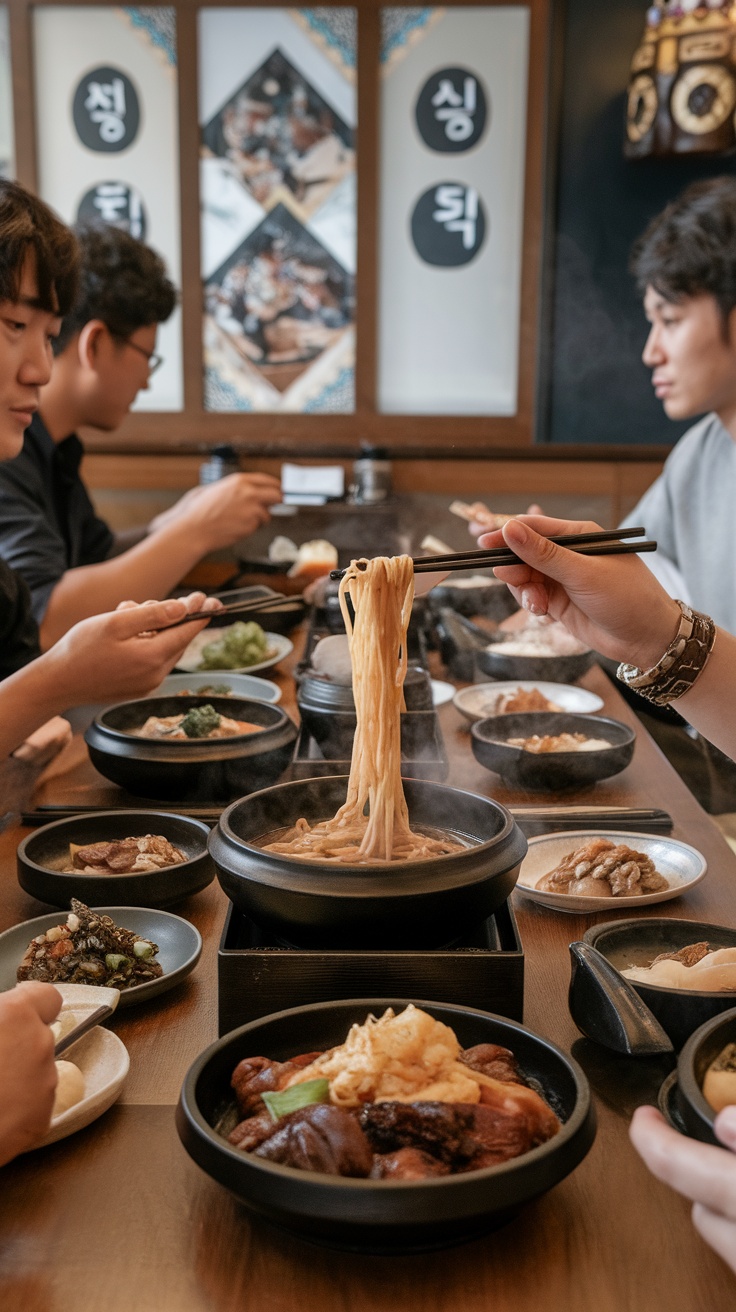
From royal court feasts to humble street stalls, Korea’s most beloved dishes are more than just meals—they’re a reflection of history, resilience, and community. Whether it’s the fiery kick of kimchi or the comforting warmth of sundubu-jjigae, each recipe carries generations of stories, shaped by geography, war, trade, and tradition. As modern adaptations continue to spread Korean flavors across the globe, one thing remains constant: the heart of Korean cuisine lies in its ability to bring people together—one delicious bite at a time.
